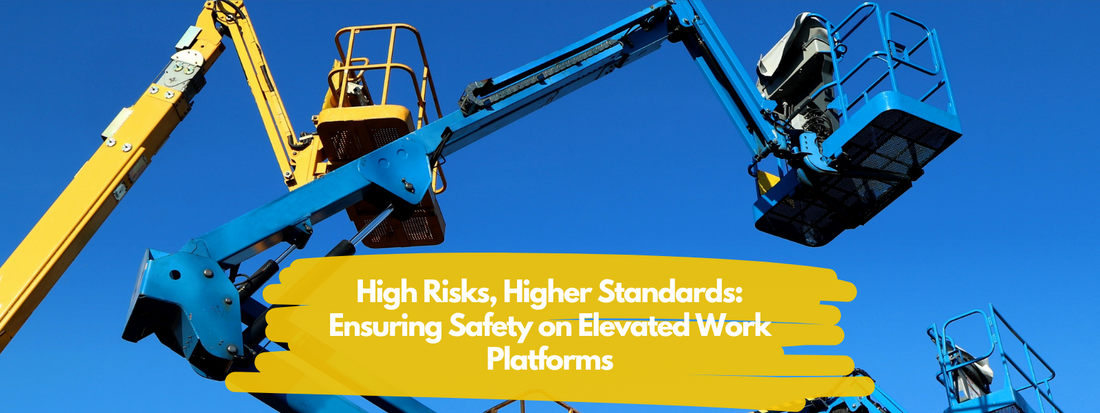
High Risks, Higher Standards: Ensuring Safety on Elevated Work Platforms (EWPs)
High Risks, Higher Standards: Ensuring Safety on Elevated Work Platforms (EWPs)
Elevated work platforms (EWPs) have revolutionized the way we perform tasks at height, offering convenience, efficiency, and accessibility to otherwise challenging areas. From construction sites to maintenance tasks, EWPs are indispensable tools across various industries. However, with the benefits of these platforms come inherent risks. Ensuring safety while operating EWPs is paramount to preventing accidents and protecting workers' lives. In this blog, we delve into an overview of safety practices on elevated work platforms, exploring key guidelines, regulations, and statistics that underscore the importance of prioritizing safety in these environments.

Understanding Elevated Work Platforms
Before delving into safety practices, it's essential to understand what elevated work platforms entail. EWPs encompass a wide range of equipment designed to lift personnel, tools, and materials to elevated work areas safely. Common types of EWPs include scissor lifts, boom lifts, cherry pickers, and scaffold towers, each serving specific purposes and configurations tailored to different job requirements.
Statistics on EWP Accidents
Despite advancements in technology and safety regulations, accidents involving EWPs still occur, underscoring the critical need for stringent safety measures. According to the Occupational Safety and Health Administration (OSHA), falls from elevated surfaces, including EWPs, consistently rank among the leading causes of workplace fatalities and injuries.
In the construction industry alone, OSHA reports that over 40% of all fatal workplace accidents involve falls, with many incidents linked to inadequate fall protection while operating EWPs. Moreover, the Bureau of Labor Statistics (BLS) highlights that a significant portion of non-fatal injuries in construction results from falls, slips, and trips, further emphasizing the urgency of implementing robust safety protocols.
Key Safety Practices on Elevated Work Platforms
- Training and Certification: Adequate training and certification for EWP operators are fundamental prerequisites for safe operation. Operators must understand the equipment's functionalities, safety features, and emergency procedures. Training programs should cover topics such as hazard recognition, fall protection, and equipment inspection.
- Pre-Use Inspections: Before each use, operators must conduct thorough pre-use inspections to identify any potential hazards or mechanical issues. Inspections typically include checking hydraulic systems, electrical components, structural integrity, and safety devices such as guardrails and harness attachment points.
- Fall Protection Systems: Implementing effective fall protection systems is crucial to mitigate the risks associated with working at height. Depending on the EWP type and operating conditions, fall protection measures may include personal fall arrest systems (PFAS), guardrails, toe boards, and restraint systems. Operators must wear appropriate personal protective equipment (PPE), including harnesses and helmets, when working on elevated platforms.
- Stability and Load Capacity: Ensuring the stability and load capacity of EWPs is paramount to prevent tip-overs and structural failures. Operators must adhere to manufacturer specifications regarding maximum load capacities, platform dimensions, and operating conditions. Avoiding overloading and maintaining a stable base are essential principles for safe EWP operation.
- Adherence to Regulations: Compliance with regulatory standards and industry guidelines is non-negotiable when it comes to EWP safety. OSHA, ANSI (American National Standards Institute), and other regulatory bodies establish stringent requirements for EWP design, operation, and maintenance. Employers and operators must stay abreast of these regulations and implement appropriate safety measures accordingly.
- Emergency Procedures : In the event of an emergency or equipment malfunction, operators must be familiar with emergency shutdown procedures, evacuation protocols, and rescue techniques. Prompt communication with supervisors and coworkers is essential to coordinate response efforts and ensure the safety of all personnel involved.
Conclusion
Elevated work platforms play a pivotal role in modern construction, maintenance, and industrial operations, enabling efficient access to elevated work areas. However, the inherent risks associated with working at height necessitate rigorous adherence to safety practices and protocols. By prioritizing comprehensive training, pre-use inspections, fall protection systems, stability considerations, regulatory compliance, and emergency preparedness, organizations can mitigate the risks associated with EWP operations and safeguard the well-being of workers.
In the pursuit of operational excellence and workplace safety, continuous education, training, and collaboration among stakeholders are imperative. Through collective efforts and unwavering commitment to safety, we can strive to create work environments where the risks associated with elevated work platforms are minimized, and every worker returns home safely at the end of the day.




